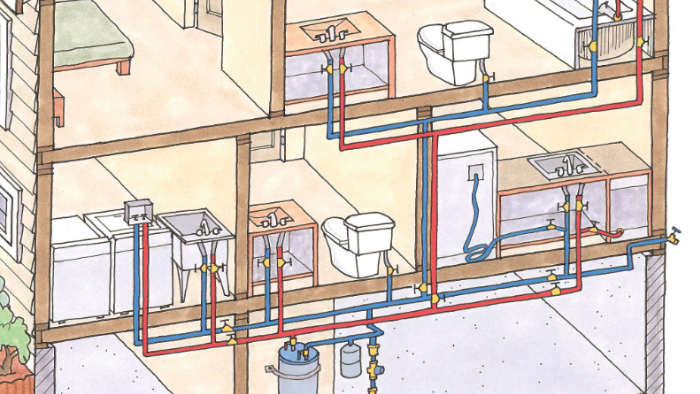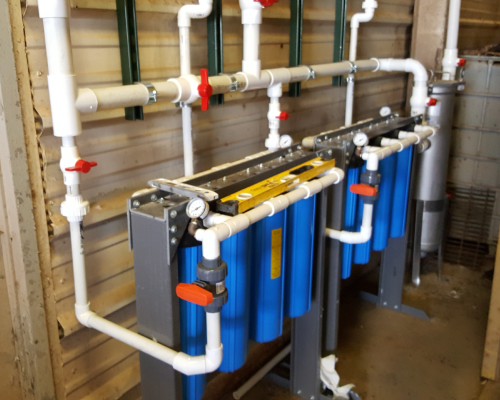Just how do you actually feel when it comes to Exploring Your Homes Plumbing Anatomy?

Recognizing how your home's pipes system functions is crucial for every single home owner. From supplying tidy water for drinking, cooking, and showering to securely getting rid of wastewater, a well-maintained plumbing system is important for your family members's wellness and convenience. In this thorough overview, we'll discover the detailed network that composes your home's pipes and deal ideas on maintenance, upgrades, and taking care of usual problems.
Introduction
Your home's plumbing system is greater than simply a network of pipelines; it's a complex system that ensures you have accessibility to tidy water and effective wastewater removal. Knowing its components and just how they collaborate can assist you prevent costly fixings and make sure whatever runs efficiently.
Standard Parts of a Plumbing System
Pipelines and Tubing
At the heart of your pipes system are the pipelines and tubes that lug water throughout your home. These can be made of numerous materials such as copper, PVC, or PEX, each with its advantages in regards to durability and cost-effectiveness.
Components: Sinks, Toilets, Showers, etc.
Fixtures like sinks, bathrooms, showers, and bathtubs are where water is made use of in your home. Understanding just how these fixtures attach to the plumbing system aids in identifying problems and intending upgrades.
Valves and Shut-off Factors
Valves regulate the flow of water in your pipes system. Shut-off valves are crucial throughout emergency situations or when you need to make repairs, enabling you to separate parts of the system without interrupting water flow to the whole house.
Water System
Main Water Line
The major water line connects your home to the local water supply or a personal well. It's where water enters your home and is dispersed to different components.
Water Meter and Pressure Regulator
The water meter procedures your water usage, while a stress regulatory authority guarantees that water streams at a safe pressure throughout your home's pipes system, preventing damage to pipelines and components.
Cold Water vs. Hot Water Lines
Understanding the difference in between cold water lines, which supply water straight from the major, and hot water lines, which bring warmed water from the hot water heater, assists in repairing and planning for upgrades.
Drainage System
Drain Pipes Piping and Traps
Drain pipelines carry wastewater away from sinks, showers, and commodes to the sewage system or septic tank. Traps stop sewer gases from entering your home and also trap debris that can create clogs.
Ventilation Pipes
Ventilation pipelines permit air right into the drainage system, avoiding suction that might slow down drain and create catches to vacant. Proper ventilation is vital for preserving the stability of your pipes system.
Importance of Proper Drainage
Guaranteeing correct drain prevents backups and water damage. Routinely cleaning drains and maintaining traps can avoid costly repair work and prolong the life of your plumbing system.
Water Heating Unit
Types of Hot Water Heater
Water heaters can be tankless or traditional tank-style. Tankless heaters heat water as needed, while storage tanks store warmed water for instant use.
Exactly How Water Heaters Link to the Plumbing System
Understanding how water heaters attach to both the cold water supply and warm water distribution lines helps in diagnosing issues like not enough warm water or leaks.
Maintenance Tips for Water Heaters
Routinely purging your hot water heater to eliminate sediment, checking the temperature level settings, and examining for leaks can expand its life expectancy and enhance energy effectiveness.
Typical Plumbing Concerns
Leaks and Their Causes
Leakages can happen due to maturing pipes, loose installations, or high water pressure. Addressing leakages quickly avoids water damages and mold and mildew growth.
Obstructions and Obstructions
Clogs in drains pipes and bathrooms are frequently caused by flushing non-flushable things or an accumulation of oil and hair. Using drainpipe screens and being mindful of what goes down your drains pipes can prevent blockages.
Signs of Pipes Problems to Expect
Low water stress, sluggish drains pipes, foul odors, or unusually high water costs are indications of potential plumbing issues that should be dealt with immediately.
Plumbing Maintenance Tips
Normal Examinations and Checks
Arrange yearly pipes assessments to catch issues early. Look for indicators of leakages, corrosion, or mineral build-up in faucets and showerheads.
Do It Yourself Upkeep Tasks
Easy tasks like cleansing tap aerators, checking for commode leaks making use of dye tablet computers, or shielding exposed pipelines in cool climates can stop major plumbing problems.
When to Call a Specialist Plumbing
Know when a pipes concern requires expert expertise. Attempting complicated fixings without proper understanding can cause even more damages and higher repair work expenses.
Updating Your Pipes System
Factors for Upgrading
Upgrading to water-efficient fixtures or replacing old pipelines can boost water top quality, reduce water costs, and raise the worth of your home.
Modern Pipes Technologies and Their Advantages
Explore modern technologies like wise leak detectors, water-saving commodes, and energy-efficient water heaters that can conserve cash and lower environmental effect.
Expense Factors To Consider and ROI
Determine the in advance expenses versus long-term savings when considering pipes upgrades. Several upgrades spend for themselves via minimized energy expenses and fewer repair work.
Environmental Impact and Preservation
Water-Saving Fixtures and Devices
Mounting low-flow taps, showerheads, and commodes can dramatically lower water use without giving up efficiency.
Tips for Minimizing Water Usage
Simple habits like fixing leakages immediately, taking shorter showers, and running full lots of laundry and dishes can preserve water and lower your utility costs.
Eco-Friendly Pipes Options
Take into consideration lasting plumbing materials like bamboo for floor covering, which is durable and green, or recycled glass for kitchen counters.
Emergency situation Readiness
Steps to Take During a Pipes Emergency situation
Know where your shut-off shutoffs are located and exactly how to switch off the water in case of a burst pipeline or major leak.
Relevance of Having Emergency Situation Get In Touches With Useful
Maintain call info for local plumbing professionals or emergency situation services conveniently available for quick action throughout a plumbing situation.
Do It Yourself Emergency Fixes (When Applicable).
Momentary repairs like using air duct tape to patch a dripping pipe or positioning a container under a dripping tap can minimize damages until a specialist plumbing technician arrives.
Verdict.
Recognizing the anatomy of your home's pipes system encourages you to maintain it properly, saving money and time on repair work. By adhering to routine upkeep routines and remaining educated about modern-day pipes innovations, you can ensure your pipes system operates effectively for several years to come.
HOW YOUR PLUMBING SYSTEM WORKS
Which Pipes Do What?
Blue lines = fresh water supply entering the building
Red lines = hot water supply entering the building
Grey lines = pipes carrying waste away from the building and venting pipes carrying gases away from the building (through the roof)
YOUR MAIN PLUMBING SYSTEMS
There are two main plumbing systems that support your home s basic plumbing needs one that brings clean water into your home, and one that sends dirty water away from your home. Connected to the toilet, bath, shower, and other faucets in your home, these two systems keep your water flowing in the right directions.
ACCESSING FRESH WATER
Fresh and clean water is brought into your home through the main water supply line . Filtered through one pipe, this water is pressured to flow into the various fixtures in your home at any given time.
This water can be sourced from a well located on your property, a pond or river (mostly cottages), or, as in most cases, from the city s municipal water treatment centre. However, it is important to note that water that is untreated, such as the water siphoned from ponds or rivers, may not be safe to drink. Personal water supplies always need to be treated for hardness and contaminants before consumed.
MUNICIPAL WATER SUPPLIES
Improve taste and odour
Remove sediment
Eliminate hardness
Reduce chlorine
COLD WATER SUPPLY VS. HOT WATER SUPPLY
Cold water flows into your home or building through the service line, which then distributes hot or cold water to your fixtures. This line is most commonly run through a central column that runs floor to floor. Hot water runs in short and straight pipes as the longer the pipeline, the more heat that will be lost in the transfer. Having shorter pipes also allows residents to access hot water more quickly.
WASTE WATER SYSTEM
Your wastewater system is divided into two parts pipes that send wastewater away from your home and venting pipes that send sewer gas away from your home. Sewage water travels through pipes that flush the water and waste towards local sewers that are operated and managed by your city or town. Most sewer systems rely on gravity to move the wastewater to where it needs to go.
The further away from your toilet or sink, the larger wastewater pipes become. This allows for waste to be disposed of from various parts of your home or business at once without pipe blockages. The angle and flow of these pipes are also essential for keeping your waste pipes clear of build up.
https://harrisplumbing.ca/how-your-home-plumbing-system-works/

HOW YOUR PLUMBING SYSTEM WORKS
Which Pipes Do What?
YOUR MAIN PLUMBING SYSTEMS
There are two main plumbing systems that support your home s basic plumbing needs one that brings clean water into your home, and one that sends dirty water away from your home. Connected to the toilet, bath, shower, and other faucets in your home, these two systems keep your water flowing in the right directions.
ACCESSING FRESH WATER
Fresh and clean water is brought into your home through the main water supply line . Filtered through one pipe, this water is pressured to flow into the various fixtures in your home at any given time.
This water can be sourced from a well located on your property, a pond or river (mostly cottages), or, as in most cases, from the city s municipal water treatment centre. However, it is important to note that water that is untreated, such as the water siphoned from ponds or rivers, may not be safe to drink. Personal water supplies always need to be treated for hardness and contaminants before consumed.
MUNICIPAL WATER SUPPLIES
COLD WATER SUPPLY VS. HOT WATER SUPPLY
Cold water flows into your home or building through the service line, which then distributes hot or cold water to your fixtures. This line is most commonly run through a central column that runs floor to floor. Hot water runs in short and straight pipes as the longer the pipeline, the more heat that will be lost in the transfer. Having shorter pipes also allows residents to access hot water more quickly.
WASTE WATER SYSTEM
Your wastewater system is divided into two parts pipes that send wastewater away from your home and venting pipes that send sewer gas away from your home. Sewage water travels through pipes that flush the water and waste towards local sewers that are operated and managed by your city or town. Most sewer systems rely on gravity to move the wastewater to where it needs to go.
The further away from your toilet or sink, the larger wastewater pipes become. This allows for waste to be disposed of from various parts of your home or business at once without pipe blockages. The angle and flow of these pipes are also essential for keeping your waste pipes clear of build up.
https://harrisplumbing.ca/how-your-home-plumbing-system-works/
Hopefully you enjoyed reading our part on Anatomy of a House: Understanding the Components. Thank you for spending some time to read through our posting. Loved our article? Please share it. Help somebody else locate it. Thanks for being here. Revisit us soon.
Get Quote